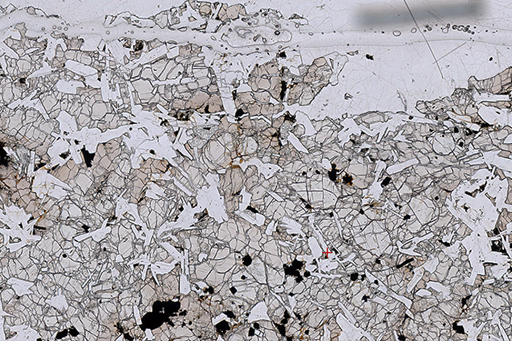2.4 Your first moon rock – a mare basalt
You can explore the Moon rocks now, using the virtual microscope tool.
First, look at sample 14053 [Tip: hold Ctrl and click a link to open it in a new tab. (Hide tip)] (open this link in a new tab or window so you have the two pages to work with), which is an aluminium-rich basalt. This sample was recovered in 1971 by the Apollo 14 astronauts Alan Shepard and Edgar Mitchell. It is a 3.92 billion-year-old piece of a lunar mare basalt that was found perched on the side of a boulder. This specimen is flat with one side freshly broken and the other side rounded and pitted by microcraters. Breccia material was found attached to the flat side, indicating that this basalt was probably a clast in the larger boulder (breccia). (Clast is the geologist’s term for a fragment of one rock found embedded in another.) There are three main types of minerals in this rock: pyroxenes, plagioclase feldspars and opaques (probably iron oxides and sulfides). When you look at it under the microscope, you should try to identify the minerals in plane-polarised light (in fact you should be able to distinguish these three even in the view here):
- pyroxene (no particular shape, pinkish-grey colour with a rough-looking cracked surface)
- plagioclase feldspars (generally long thin crystals, clear or white and with very little visible internal structure)
- ilmenite (opaque).
Are there any other features of this rock that distinguish it from its equivalent on Earth? Compare this rock with a basalt that erupted on Earth.
There are several basalts on the Virtual Microscope Website, including the basalt that forms the Giant’s Causeway in Northern Ireland.

